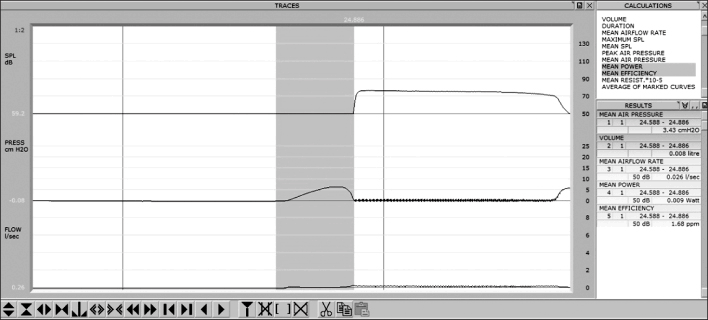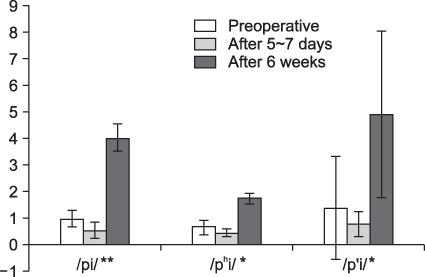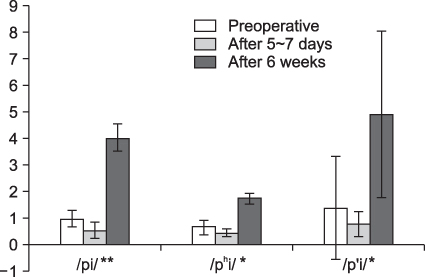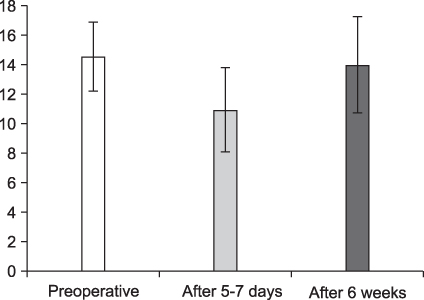Abstract
Background and Objectives
This study is to prospectively compare and analyze the aerodynamic changes in the patients with thyroid cancer before and after surgery. Changes in vocal function before and after thyroidectomy were examined using aerodynamic and related assessments.
Materials and Methods
Twenty one patients were evaluated preoperatively, 5-7 days and 6-7 weeks postoperatively to assess aerodynamic outcomes after thyroidectomy. Glottal input power (GIP), glottal efficiency (GE) and maximum phonation time (MPT), were determined the time of before surgery, 5-7 days after surgery and 6-7 weeks after surgery.
Results
According to the comparison analysis of the three periods, GIP with /pi/ phonation was significantly reduced at time of 5-7 days and 6-7 weeks after surgery, but not in the /phi /and /p’i/ phonations. GE was significantly reduced in the /pi/, /phi /and /p’i/ phonations at time of 5-7 days and 6-7 weeks after surgery. MPT was significantly reduced at time of 5-7 days after surgery significantly.
Go to : 
References
1. Hong KH, Kim YK. Phonatory characteristics of patients undergoing thyroidectomy without laryngeal nerve injury. Otolaryngol Head Neck Surg. 1997; 117(4):399–404.

2. Meek P, Carding PN, Howard DH, Lennard TW. Voice change following thyroid and parathyroid surgery. J Voice. 2008; 22(6):765–772.

3. Maeda T, Saito M, Otsuki N, Morimoto K, Takahashi M, Iwaki S, et al. Voice quality after surgical treatment for thyroid cancer. Thyroid. 2013; 23(7):847–853.

4. Franco RA, Andrus JG. Aerodynamic and acoustic characteristics of voice before and after adduction arytenopexy and medialization laryngoplasty with GORE-TEX in patients with unilateral vocal fold immobility. J Voice. 2009; 23(2):261–267.

5. Dursun G, Gokcan MK. Aerodynamic, acoustic and functional results of posterior transverse laser cordotomy for bilateral abductor vocal fold paralysis. J Laryngol Otol. 2006; 120(4):282–288.

6. Lombardi CP, Raffaelli M, D\'Alatri L, Marchese MR, Rigante M, Paludetti G, et al. Voice and swallowing changes after thyroidectomy in patients without inferior laryngeal nerve injuries. Surgery. 2006; 140(6):1026–1032. discussion 32-4.

7. Piccirillo JF, Painter C, Fuller D, Fredrickson JM. Multivariate analysis of objective vocal function. Ann Otol Rhinol Laryngol. 1998; 107(2):107–112.

8. Zhang Y, Jiang JJ. Acoustic analyses of sustained and running voices from patients with laryngeal pathologies. J Voice. 2008; 22(1):1–9.

9. Wolfe V, Martin D. Acoustic correlates of dysphonia: type and severity. J Commun Disord. 1997; 30(5):403–415. quiz 15-6.

10. Sonesson B. Vocal fold kinesiology. In: Grillner S, Lindblom B, Lubker J, Persson A, editors. Speech motor control. Oxford: Pergamon; 1983. pp. 113-117.
11. Solomon NP, Garlitz SJ, Milbrath RL. Respiratory and laryngeal contributions to maximum phonation duration. J Voice. 2000; 14(3):331–340.
12. Dart SN. An aerodynamic study of Korean stop consonants: measurements and modeling. J Acoust Soc Am. 1987; 81(1):138–147.

13. Hartl DM, Hans S, Vaissiere J, Brasnu DF. Laryngeal aerodynamics after vocal fold augmentation with autologous fat vs thyroplasty in the same patient. Arch Otolaryngol Head Neck Surg. 2005; 131(8):696–700.

14. Hong KH, Kim HK, Niimi S. Laryngeal gestures during stop production using high-speed digital images. J Voice. 2002; 16(2):207–214.

15. Hong KH, Kim HK. Electroglottography and laryngeal articulation in speech. Folia Phoniatr Logop. 1997; 49(5):225–233.

16. Isshiki N, Shoji K, Kojima H, Hirano S. Vocal fold atrophy and its surgical treatment. Ann Otol Rhinol Laryngol. 1996; 105(3):182–188.

17. Solomon NP, Helou LB, Stojadinovic A. Clinical versus laboratory ratings of voice using the CAPE-V. J Voice. 2011; 25(1):e7–e14.

18. Van Lierde K, D\'Haeseleer E, Wuyts FL, Baudonck N, Bernaert L, Vermeersch H. Impact of thyroidectomy without laryngeal nerve injury on vocal quality characteristics: an objective multiparameter approach. Laryngoscope. 2010; 120(2):338–345.

19. Ryu J, Ryu YM, Jung YS, Kim SJ, Lee YJ, Lee EK, et al. Extent of thyroidectomy affects vocal and throat functions: a prospective observational study of lobectomy versus total thyroidectomy. Surgery. 2013; 154(3):611–620.

Go to : 




 PDF
PDF ePub
ePub Citation
Citation Print
Print






 XML Download
XML Download